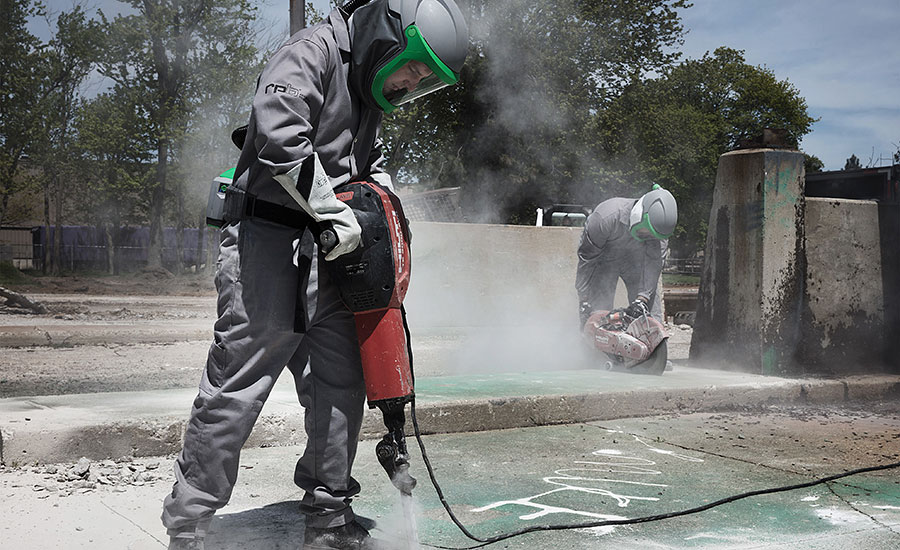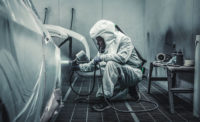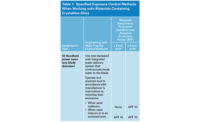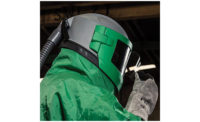Reduce the Risk: Complying with OSHA’s crystalline silica rule

Crystalline silica is an abundant natural material found in soil, stone and sand. It is also present in many construction materials such as brick, mortar and concrete. It becomes respirable when any of the afore-mentioned materials are cut or broken down into fine particles.
Typical activities that can create silica dust or respirable crystalline silica include blasting, chipping, cutting, grinding and drilling. More than 85 percent of workers exposed to respirable crystalline silica work in the construction industry. Other industries where workers are exposed include: asphalt roofing materials, concrete products, cut stone, dental laboratories, foundries, jewelry, porcelain enameling, pottery, railroads, ready-mix concrete, shipyards, structural clay products, and support activities for oil and gas operations.
Effects of inhaling
It is important to note that the effects of inhaling crystalline silica are cumulative and can go unnoticed for up to ten years. Below are some of the illnesses that can be caused by excessive inhalation of crystalline silica:
- Silicosis – a disease where the lungs react to trapped particles of silica by scarring and forming hard nodules. When these nodules become large, it becomes difficult to breathe and can be fatal. Silicosis is irreversible and continues to worsen even after exposure has ceased.
- Lung Cancer
- Tuberculosis (increased risk for those with silicosis)
- Chronic Obstructive Pulmonary Disease (COPD)
Regulatory benefits
Almost two years ago, OSHA reduced the Permissible Exposure Limit (PEL) of Crystalline Silica for workers to 50µg/m3 averaged over an eight-hour day.
OSHA estimates that the rule will save over 600 lives and prevent more than 900 new cases of silicosis each year, once its effects are fully realized. The Final Rule is projected to provide net benefits of about $7.7 billion, annually.
Employer responsibilities
OSHA has reduced the Permissible Exposure Limit (PEL) of Crystalline Silica for workers to 50µg/m3 averaged over an eight-hour day. With the reduction in the PEL, employers now must:
- Measure how much silica their employees are exposed to if it is likely to be above the action limit of 25 µg/m3 averaged over an eight-hour day
- Provide their employees with protection from crystalline silica if more than 50µg/m3
- Limit worker access to areas where silica levels are above the PEL
- Take measures to control the dust where silica levels are above the PEL
- Provide respiratory protection where dust control measures fail to reduce the silica levels to below the PEL
- Offer alternative housekeeping practices to those that expose workers to silica whenever feasible
- Develop and execute a written “exposure control plan” that details work that involves exposure to silica and protection measures
- Offer regular medical examinations for workers exposed to the action level for over 30 days per year.
At-risk employees
Changes for employees will depend on activities and environments, but here are some examples of what to expect:
- The company you work for will have a written Silica Exposure Control Plan that you should be aware of and comply with.
- You may be required to use dust control equipment more often.
- You may be required to wear a respirator more often
- You may be required to, or given the option to, take regular medical examinations. Our advice to employees is to understand the risk of exposure to crystalline silica and comply with any measures your employer takes to minimize these risks.
Protect yourself
Here are various ways you can limit exposure to respirable crystalline silica:
- Use water to control dust. Two examples of this are concrete saws with integrated water delivery and slurry blasting. This reduces the amount of airborne crystalline silica but does not eliminate it.
- Use dust extraction systems. This removes most of the airborne crystalline silica from the air, however depending on the setup, it does not eliminate exposure.
- Use a respirator. When choosing your respirator pay attention to the fit. Even if fit-tested regularly, the seal can be jeopardized by facial hair (as little as half a day’s growth). Loose-fitting, supplied air respirators don’t require a seal to provide respiratory protection. Negative pressure respirators rely on the wearer’s breathing to provide filtered air. Supplied air respirators use a fan, compressed air, or a pump to provide filtered air.
References:
- Work Safely With Silica. http://www.silica-safe.org
- OSHA® Fact Sheet 3681: OSHA’s Crystalline Silica Rule: Construction. https://www.osha.gov/pls/publications/publication.athruz Ptype=Industry&pid=192
- OSHA® Fact Sheet 3682: OSHA’s Crystalline Silica Rule: General Industry and Maritime. https://www.osha.gov/pls/publications/publication.athruz Ptype=Industry&pid=192
- Crystalline Silica. https://www.cancer.gov/about-cancer/causes-prevention/risk/substances/crystalline-silica
Looking for a reprint of this article?
From high-res PDFs to custom plaques, order your copy today!





